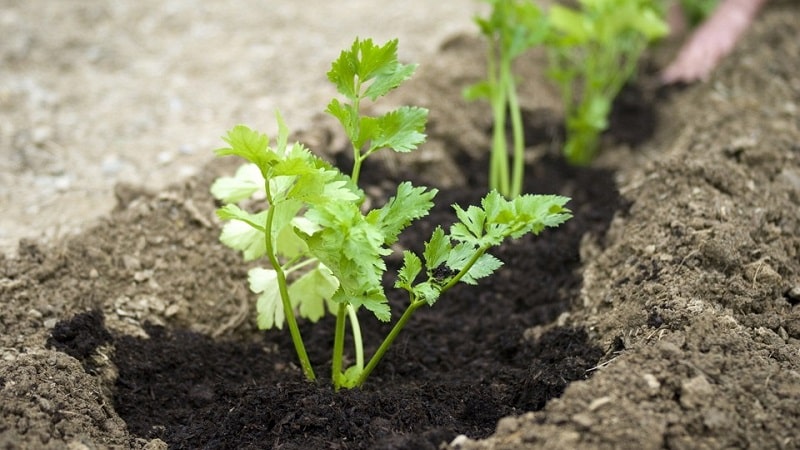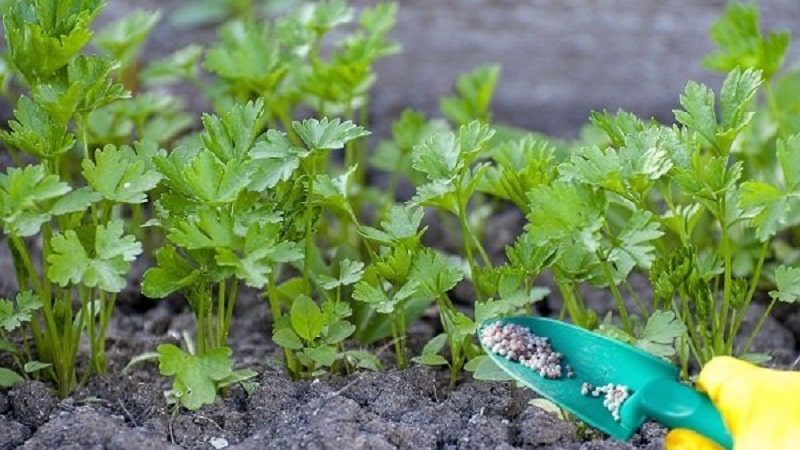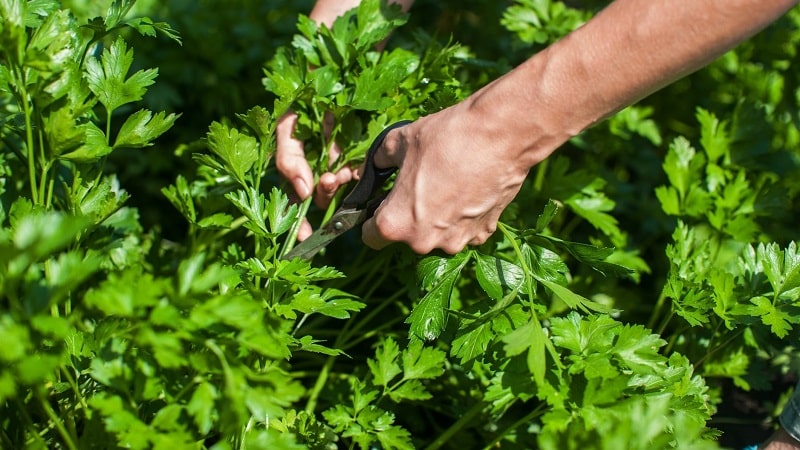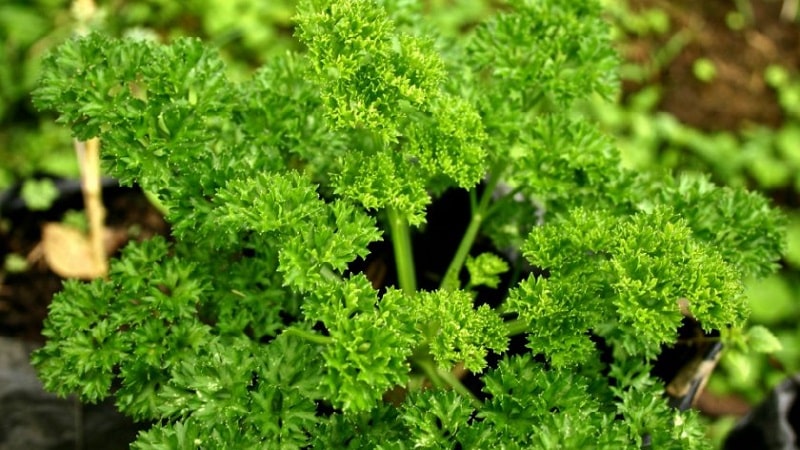How, when and what to feed parsley for growth: tips for beginning gardeners
Parsley appears in gardens in early May. Rich in vitamins and microelements, it has a positive effect on human health: improves heart function, normalizes blood pressure and the immune system. Vitamins A, K, C, which are part of it, strengthen bones and help fight vision problems. Regular consumption of parsley will compensate for the lack of calcium, phosphorus, magnesium, and iron in the body. It is used in cooking for preparing first and second courses.
In this article we will talk about the features of growing the crop, how to feed parsley for growth and yield, and when to apply fertilizer for leaf and root varieties.
Types of fertilizers for parsley
Parsley is a biennial plant that belongs to the celery family.. Highlight:
- Root varieties - consume the root and leaves.
- Leafy varieties - only greens.
Properly selected fertilizers help to grow crops. Depending on the type of crop and timing of fertilizing, apply:
- organic;
- mineral;
- humic.

Organic
Gardeners who want to get an environmentally friendly product use organic fertilizers to increase their yield. They are brought in in early spring or late autumn for digging - 5-8 kg per 1 m².
Nitrogen fertilizers are used for leaf varieties: humus, rotted manure, bird droppings. For root parsley, phosphorus-potassium fertilizers are used: sawdust, compost, peat.
When the second leaves appear, use a herbal infusion. It is prepared from any weed herbs. The infusion is kept for 10 days, then diluted with water in a ratio of 1:10 and watered. The procedure is carried out once every two weeks.
Important! For infusion, take grass without seeds.
Mineral
Mineral fertilizers replenish the crop's need for nutrients:
 Simple ones contain one substance. These are ammonium nitrate, potassium salt, urea, superphosphate. When digging in the fall, 30 g of superphosphate and 20 g of potassium salt are added per 1 m². If not applied in the fall, then after the first leaves appear, water with a solution of 10 g of ammonium nitrate, 5 g of superphosphate and 8 liters of water.
Simple ones contain one substance. These are ammonium nitrate, potassium salt, urea, superphosphate. When digging in the fall, 30 g of superphosphate and 20 g of potassium salt are added per 1 m². If not applied in the fall, then after the first leaves appear, water with a solution of 10 g of ammonium nitrate, 5 g of superphosphate and 8 liters of water.- Complex include several elements. Recommended preparations for parsley: “Nitroammofoska”, “Diammofos”, potassium nitrate, “Ammophos”. They are brought in for digging in the fall or early spring.
Fertilizer doses depend on soil type:
- Wood-podzolic soils require 9 g of nitrogen, 9 g of phosphorus, 18 g of potassium.
- Floodplain meadows - 6 g nitrogen, 9 g phosphorus, 20 g potassium.
- 6 g of nitrogen, 8 g of phosphorus, 12 g of potassium are added to the chernozem.
- Swampy soils - 3 g nitrogen, 12 g phosphorus, 25 g potassium.
Exceeding the dose will worsen harvest quality.
Nitrogen fertilizers are applied in May. The dose of nitrogen is no more than 5 g per 1 m² of land. Potash fertilizers have been used since the beginning of August. The norm per 1 m² is 9 g. Complex fertilizers are often used together with organic ones.
Humic
These fertilizers are made from organic matter. They use manure, silt, brown coal, and vegetable compost. Humic fertilizers are applied three times per season, alternating root and foliar feeding:
- To ensure rapid germination, seeds are soaked in the peat-humic preparation “Flora-S” before sowing.
- To accelerate the development of the root system and increase green mass, the drug “Gumimax” is used in July.
- In August, the drug “Fitop-Flora-S” is used to combat pathogenic putrefactive microflora.
Solutions used only fresh.

Folk recipes
To feed parsley, herbal infusions, yeast, whey, and pharmaceutical preparations are used.: iodine, hydrogen peroxide, brilliant green. Fertilizing is carried out by root and foliar methods. These types of fertilizers are environmentally friendly and safe for human health.
Interesting things on the site:
Diseases and pests of parsley: photos, control and prevention
How parsley helps with puffiness under the eyes and how to use it
Several recipes:
- Whey with iodine prevents the development of diseases and provides nutrients. Mix 5 liters of water, 4 drops of iodine, 0.5 liters of whey.
- Liquid bird droppings are used as nitrogen fertilizer to increase greenery. Bird droppings are poured with water and left for a week. Then dilute with water in a ratio of 1:20 and water at the root.
- Regular pharmaceutical greens have a positive effect on the growth of parsley. 10-12 drops of brilliant green are diluted in 8 liters of water. Treat the greens and soil around the plants.
Best Remedies for Parsley Growth
If you notice limp leaves on plants that have turned yellow at the bottom, this means they are lacking nutrients. Let's take a closer look at what to do in this case.

What to feed if it doesn’t grow, doesn’t sprout, grows poorly
So that the seeds germinate quickly, soak them for 1-2 hours in a solution of humic fertilizers.
If parsley does not sprout or grows poorly, use nitrogen fertilizers. Weak young shoots are fed with a solution of 1 tbsp. l.ammonia and 8 liters of water. Water at the root.
After 14 days, foliar and root fertilizing with hydrogen peroxide is carried out. They improve the soil structure and give the leaves a rich color. 1-2 tbsp. l. peroxides are diluted in 1 liter of water. The procedure is repeated every two weeks.
How to feed parsley for growth at different times
It is important to take care of the harvest throughout the season. Let's look at the growth periods of parsley and feeding options.
After landing
In the fall, fertilizer is applied for digging per 1 m²: 3-5 kg of rotted manure or humus and 2 tbsp. l. "Nitroammofoski". Or 30 g of superphosphate and 20 g of potassium salt. If you didn’t have time to apply fertilizer in the fall, do it in the spring before planting the seeds.

After germination
The first feeding is carried out after the appearance of the second leaf.. Use nitrogen fertilizers. For 1 m² - 1 tbsp. l. ammonium nitrate and 10 liters of water or 1 tbsp. l. ammonia in a bucket of water. Water at the root.
Attention! Urea and other nitrogen fertilizers are applied only if the plants' leaves turn yellow.
Two weeks after the first feeding, the plantings are treated with a solution hydrogen peroxide - 1-2 tbsp. l. for 1 liter of water. This fertilizing enriches the soil with oxygen, strengthens roots, and helps fight diseases. Spray the leaves and water at the root.
When the green mass gains strength, it is cut off and carry out phosphorus-potassium fertilizing to strengthen the roots:
- Herbal infusion from weeds: the grass is placed in a bucket, filled with water, and infused for 1-2 weeks. The infusion is diluted with water in a ratio of 1:8.
- Yeast feeding: 0.5 kg of fresh yeast, 0.5 liters of jam, 5 liters of warm water, leave for 24 hours. The solution is diluted in water in a ratio of 1:8.
Root parsley is fed with a mineral composition in the second half of summer: 10 g of superphosphate and 8 g of potassium nitrate.

How to fertilize correctly
Parsley absorbs not only nutrients from the soil, but also nitrates. Keep this in mind when using fertilizers.
Instructions
Main rules for applying fertilizers:
- When starting planting, pay attention to the condition of the soil. The amount of fertilizer depends on how depleted the soil is. Cultivated soils require less fertilizing - 20 g per 1 m² is enough. For infertile land, 40 g per 1 m² is required.
- Before adding superphosphate, deoxidize the soil with wood ash - 200 g per 1 m².
- Mineral fertilizers - ammonium nitrate, simple superphosphate - use after cutting greenery.
- Add double superphosphate granules to the soil before digging so that the drug is completely dissolved.
- Fertilize after watering to avoid damaging the root system.
- Do not mix superphosphate with ammonium nitrate, lime or urea.
Precautionary measures
By treating plants with various preparations and infusions, don't forget about precautions:
- Follow proportions in recipes.
- If mineral fertilizers get on the leaves, wash them off immediately with water.
- Don't overfeed your plants.
- Wash your hands after using mineral fertilizers.
Features of fertilizing root and leaf parsley
Root parsley has a developed root, similar to a carrot, and some leaves. For root growth phosphorus-potassium fertilizers are needed. In July and August, 7 g of superphosphate and 5 g of potassium salt, diluted in a bucket of water, are added per 1 m².

Leaf parsley produces a bountiful harvest of green massTherefore, the emphasis is on nitrogen nutrition. They feed culture every time after cutting leaves.Add 5 g of ammonium nitrate per 1 m² or use a solution of ammonia - 1 tbsp. l. for 8 liters of water.
Adviсe
When starting to grow crops, remember the following rules:
- parsley does not tolerate fresh manure;
- the best predecessors are cucumbers, cabbage, potatoes;
- plant seeds in carefully dug soil;
- if the soil in the garden is heavy, add peat or humus before planting;
- the plant better accepts small portions of fertilizing;
- use planting under the predecessor - fertilize the plant after which you plan to plant parsley;
- Fertilize only if the summer is cold or the soil is poor.
Conclusion
We figured out how to grow parsley and how to fertilize it for a large harvest. Feed the plant at least three times a season. Starting in late autumn, humus, compost, superphosphate with potassium salt are added to the digging. In the spring, before planting, soak the seeds in a solution of humic fertilizers.
The first feeding is carried out after the second leaves grow. Subsequent ones - after each collection of greens. To grow more green mass, nitrogen fertilizers are used. For the development of the root part, phosphorus-potassium is used. It is better to plant parsley after cucumbers, tomatoes, and potatoes. To obtain an environmentally friendly product, use organic fertilizers.